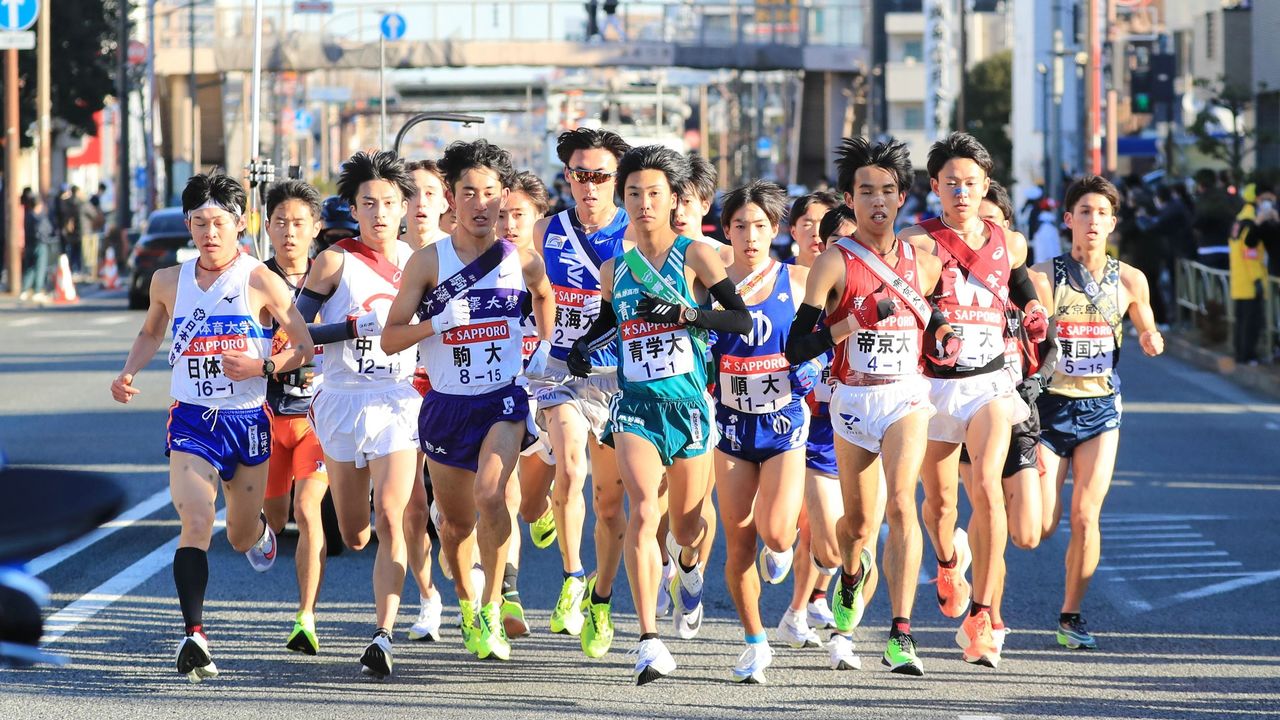
The Hakone Ekiden: An Annual Tradition and Touchstone for Japanese Sports Fandom
Sports Society Education History- English
- 日本語
- 简体字
- 繁體字
- Français
- Español
- العربية
- Русский
A New Year Tradition
The Hakone Ekiden is a marquee event on the annual athletic calendar in Japan. Taking place on January 2 and 3 each year, this long-distance relay race pits university men’s teams against each other over a 217.1-kilometer round-trip course, with five runners passing a tasuki, a cloth sash serving as the relay baton, over five legs totaling 107.5 kilometers from Tokyo’s Ōtemachi district to Ashinoko, the mountain-ringed lake in Hakone, Kanagawa, on the first day and five more legs totaling 109.6 kilometers back the next day.
Each year 21 teams take part, with 10 having secured spots in the race by finishing in the top 10 positions in the previous year’s race, another 10 winning their chance in a preliminary contest, and a team of top runners from universities that do not qualify to send teams to the Hakone Ekiden. The race is also a major event on the New Year television schedule; Nippon TV airs the race in full, garnering ratings as high as 30%. Unlike most New Year programming, the show features no comedians or other celebrities in the studio, instead relying on past heroes of the long-distance event to provide commentary on the competition.
The race has risen to prominence in the last few decades, explains one broadcast industry representative. “During the Shōwa era [1926–89], the university sport getting the most public attention was the Tokyo Big6 Baseball League, with teams from six leading Tokyo universities taking part. Once we entered the Heisei era [1989–2019] rugby gained popularity, and matches between Waseda and Meiji Universities saw double-digit ratings on TV. From the mid-1990s on, though, it’s the Hakone Ekiden that has steadily risen as the most popular university sporting event.”
Hara Susumu, head coach of the powerhouse Aoyama Gakuin University team that has won six Hakone titles since 2015, notes that the rising prominence of the race may be prompting highly athletic young men to opt for distance running rather than other sports in recent years. “It feels like some of the athletes who once would have gravitated toward baseball, soccer, or other sports with professional leagues to shoot for have been coming to long-distance running instead. In the last few years our school has seen the arrival of new students who are well-rounded athletes with high levels of talent in more than just running. It’s likely that the inspiration of Hakone has played a role in their development.”
Birth of the Modern Ekiden
Near one end of the Sanjō Ōhashi, a bridge over the Kamo River in Kyoto, stands a plaque commemorating the location’s status as “the birthplace of ekiden racing.” On April 27, 1917, teams of runners began a race at this spot taking them all the way to Shinobazu Pond in Tokyo’s Ueno district, a 23-leg ultradistance race spanning some 508 kilometers in all. This competition, Japan’s first ekiden, was between two teams representing the Kantō region centered on Tokyo and the Kansai region home to Kyoto and Osaka. The runners continued night and day, with the Kantō anchor Kanakuri Shizō—who had represented Japan in the marathon competition at the 1912 Stockholm Olympics—crossing the finish line first two days after the race began.
Three years later, in 1920, the Tokyo Higher Normal School (later the Tokyo University of Education, and today the University of Tsukuba), Waseda University, Keiō University, and Meiji University took part in the first-ever Hakone Ekiden. For more than a century since these four schools kicked off the annual contest, runners have kept the tasuki moving along the Tokyo-Hakone course.
Along the way, the race has produced more than its fair share of heroes, Seko Toshihiko, who ran for Waseda at Hakone for four straight years from 1977 to 1980, went on to compete for Japan in the marathon at the Los Angeles and Seoul Olympics in 1984 and 1988. Tōyō University’s Kashiwabara Ryūji earned himself the nickname Yama no Kami, “Mountain God,” for his four blistering performances in 2009–12 on the brutal fifth leg that climbs the hills to Ashinoko. And Ōsako Suguru, who came in sixth in the Tokyo Olympic marathon last year, made a name for himself as an ace runner for all four of his years at Waseda (2011–14).
Beyond the individual stars it showcases, the Hakone Ekiden is also known for the drama it provides in the form of the down-to-the-wire dashes between perennial rival schools, like Aoyama Gakuin and Komazawa University, or the come-from-behind victories engineered on the second day of competition, as runners return to Tokyo. This race is the only running event to consistently be featured in special editions of Japan’s major sports magazines.
We actually speak of Hakone as just one of the “three great collegiate ekiden races” in the country, also including the Izumo Ekiden in Shimane Prefecture and the All Japan Inter-University Ekiden Championship, held on a course spanning Aichi and Mie Prefectures. As popular as these other races are in their own right, though, they cannot hold a candle to Hakone.
Why should this be the case, though, when the Hakone Ekiden is fundamentally a regional tournament for schools in and around Tokyo? One reason is the power of television. The race has been broadcast live in full since 1987, the seventieth year of ekiden racing in Japan, and its nationwide popularity has only grown since then. Today, relaxing in front of the television on January 2 and 3, enjoying the New Year holidays with the annual race on in the background, is a firmly established tradition in many Japanese homes.
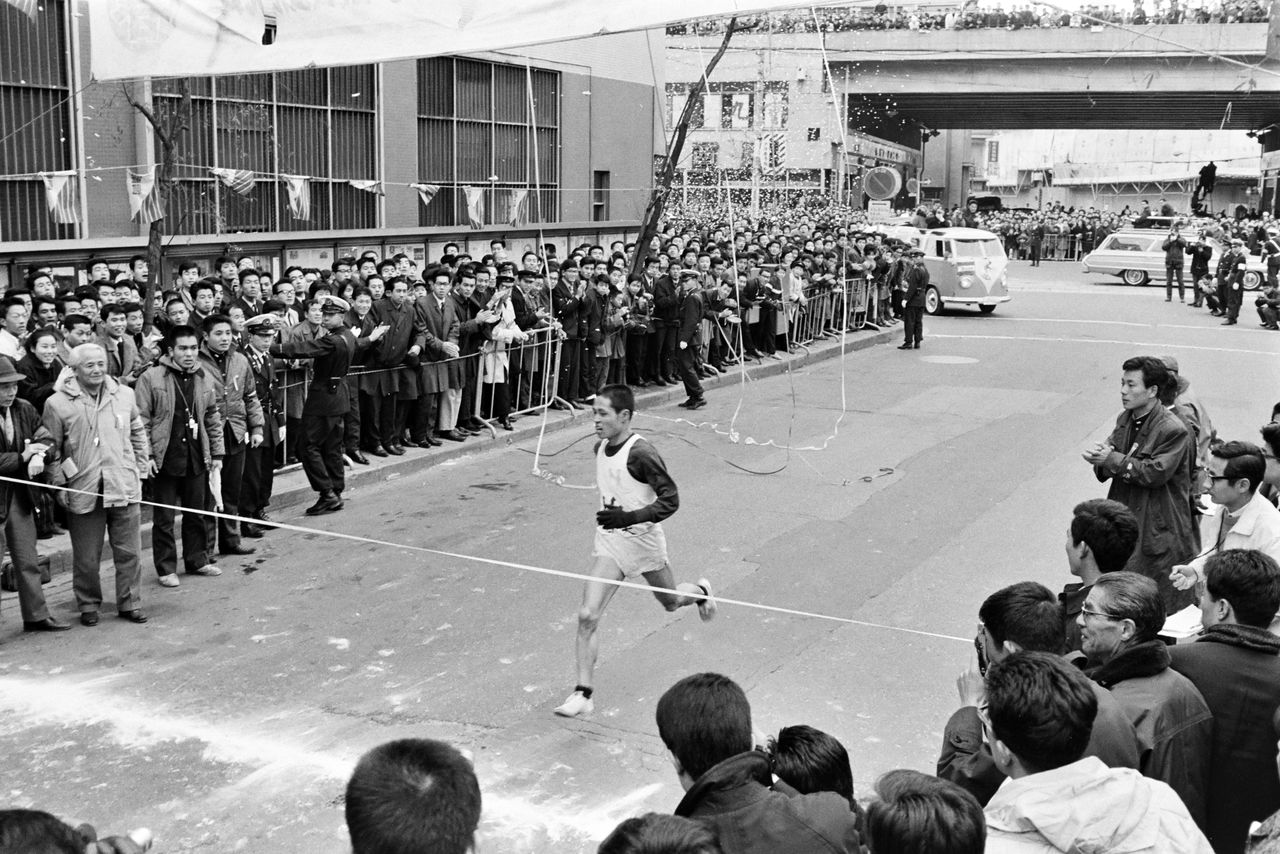
Nihon University’s anchor reaches the ribbon to win the forty-first Hakone Ekiden on January 3, 1965. Nihon University won in convincing style, taking first in both the first day to Hakone and the second day of competition. Taken at the finish line in front of the Yomiuri Shimbun head office in Ginza, Tokyo. (© Jiji)
This race takes more than 11 hours over two days, making it quite different from a soccer or rugby match, where the results are clear in a matter of two hours or so. This makes it something that is hard to focus on for the entire time. But for the lazy holidays at the beginning of the year, this sort of entertainment, with competition that viewers can dip in and out of at their leisure, is perfect television. The early morning sunshine that welcomes the runners onto the first leg, along with the splendid views of the Pacific Ocean and Mount Fuji that the course provides, are also great matches for the New Year mood.
Another reason for the race’s popularity is its status as a pure student sporting event. Other races, where many of the runners run for corporate teams, have a much stronger flavor of advertising for the athletes’ sponsors. It is far easier to cheer wholeheartedly for the young amateurs on the college teams, and there are doubtless many who cheer on athletes from certain schools even without being alumni of the same institutions.
Taiwan has recently seen an uptick in interest in the Hakone race, and powerhouse Aoyama Gakuin University is particularly popular. In 2017, when the team had won the race for the third straight year, some of its members appeared on a Japanese variety show that was rebroadcast in Taiwan. The young athletes’ cheerful and open demeanor won them many fans among young TV viewers there. (Indeed, over my years of covering the university’s running program, I have noted that just about all of its runners excel at public communication—likely a reflection of head coach Hara Susumu’s insistence on making expressive ability one of the yardsticks for use when recruiting prospective team members.) Their appearance on this show apparently inspired some Taiwanese high school students to declare that they hoped to study abroad at Aoyama Gakuin.
Most of the strongest runners who take part in the Hakone Ekiden go on to run for corporate teams while training for major races, continuing their competitive careers. When I speak to these top athletes, many of them note wryly that the media attention they receive has dwindled considerably compared to the days when they were Hakone runners—yet more evidence for the outsized impact this ekiden race has on the sports and journalism worlds.
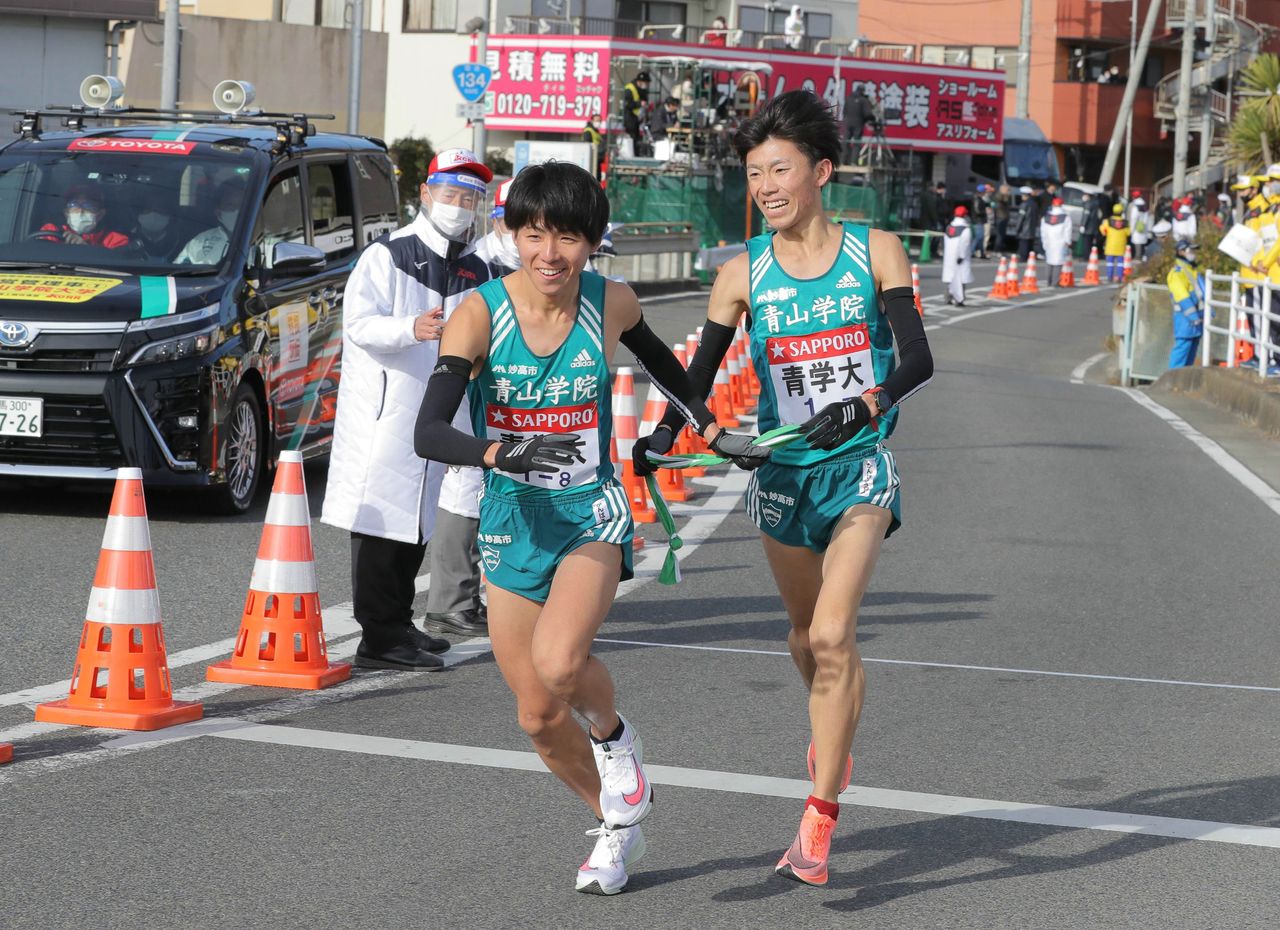
Aoyama Gakuin’s Kondō Kōtarō, at right, completes the seventh leg of the 2021 Hakone Ekiden and hands the tasuki to teammate Iwami Shūya, the eighth-leg runner. The team placed fourth this time, but has been hard to beat in recent years, winning six of the eight races since 2015. Taken at the hand-off point in Hiratsuka, Kanagawa, on January 3, 2021. (© Jiji)
A Rare Team Event in the Track and Field World
The ekiden is a type of race invented in Japan, which I believe gives some insight into the Japanese preference for team sports over individual athletic endeavors. During my time covering the World Athletics Championships and Olympic Games, I have rarely seen any tendency in countries like the United States or Britain, home to top athletes and numerous fans, to view track and field events as team sports. Track and field athletes are seen across the board as individual competitors pitting their bodies and talents against one another in pursuit of victory. The champion in the 100-meter dash is therefore celebrated as “the fastest human on Earth,” and the high-jump gold medalist as the “highest leaper in the world.”
In Japan, though, particularly since the 2008 Beijing Olympics, when the men’s 400-meter relay team brought home the silver medal, this relay has been one of the most popular track and field events in the country. Today there are four Japanese runners who have broken the 10-second mark in the 100-meter dash, bringing this race fresh popularity among fans hoping to see a Japanese competitor in the medal race, but the 400-meter relay was still one of the biggest draws at the Tokyo Olympics last year. (Sadly, a flubbed baton pass removed Japan from medal consideration.) Japan remains a nation with a particular fondness for the handful of team events on the track.
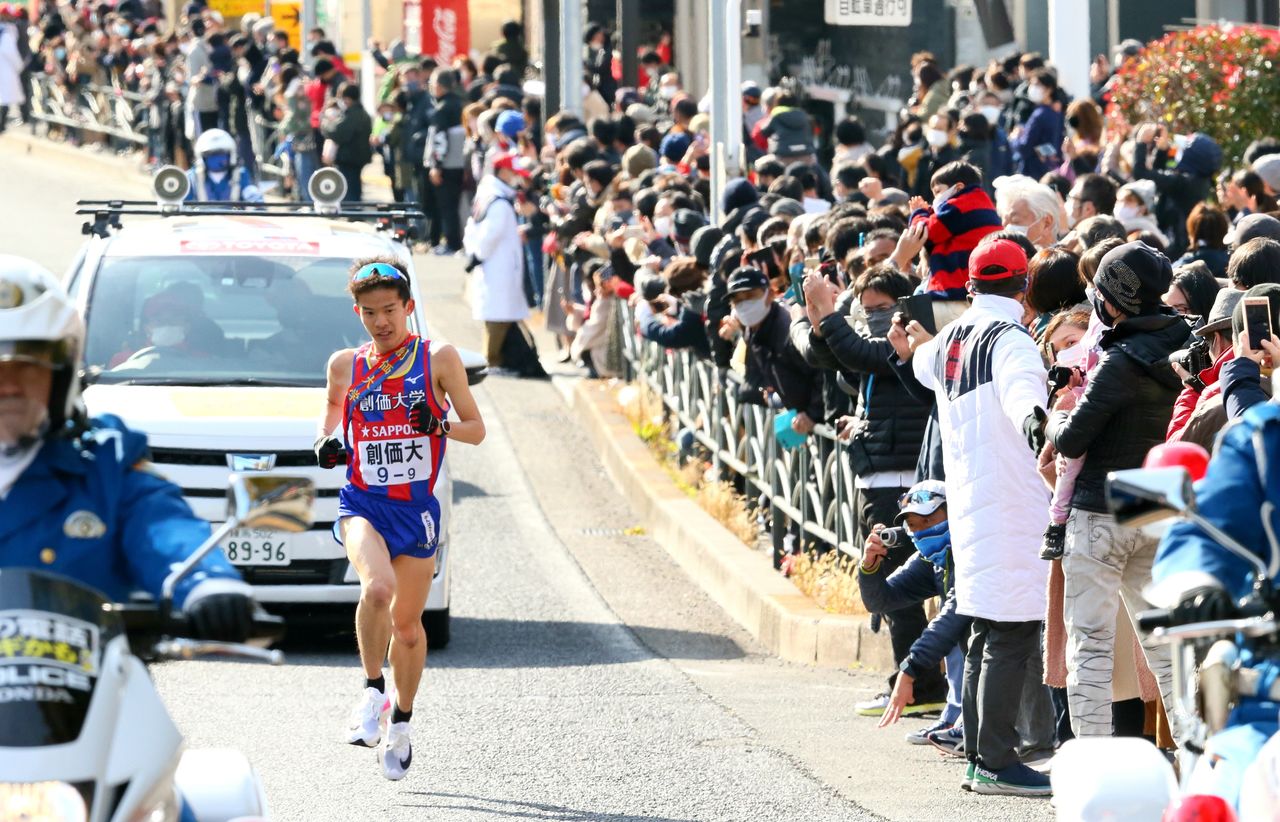
Ishizu Yoshiaki turns in a strong performance in the ninth leg of the 2021 Hakone Ekiden. His Sōka University team went on to place second overall. Taken on January 3 in Yokohama, Kanagawa. (© Jiji)
This preference for team sports has been seen across all types of athletic competition throughout the modern era. For decades baseball has remained atop the Japanese sporting world in terms of its popularity. During the 1964 Tokyo Olympics, the highest TV ratings went to the women’s volleyball competition. Soccer draws consistently large audiences, thanks to the women’s national team’s prowess and the men’s improvement to the point where they can generally be counted on to make it to the round of 16 in international tournaments. Japan’s rugby team, which shocked the world with a win over powerhouse South Africa in the 2015 World Cup and made it to the round of eight in the 2019 World Cup hosted in Japan, also enjoys huge popularity.
This is not to say, of course, that Japan has not celebrated its individual sports stars. The country has produced its share of top boxers, jūdōka, marathon runners, and others capable of winning on the world stage. Tennis players like Nishikori Kei and Ōsaka Naomi, ranked number one in the world at one point, have won tremendous fame and popularity in recent years. It is hard to say, though, whether similar Japanese standouts will continue to appear in sports like theirs.
We can continue to count on the Hakone Ekiden to produce a steady stream of popular athletes, though, thanks to the twin qualities that have propelled it to the top in Japan—its status as a student competition and its nature as a team event.
Helping Each Other to Excel
Ekiden races are popular whenever they take place in Japan, and the Hakone Ekiden stands at the top of the heap. The race is not won by individuals, but by teams of 10 runners combining their efforts to carry the tasuki across the finish line. In this year’s race, Juntendō University runner Miura Ryūji, who placed seventh in the 3,000-meter steeplechase in the Tokyo Olympics last summer, attracted plenty of attention early on, but in the end even this Olympian was only one member of the Juntendō team that finished second behind Aoyama Gakuin.
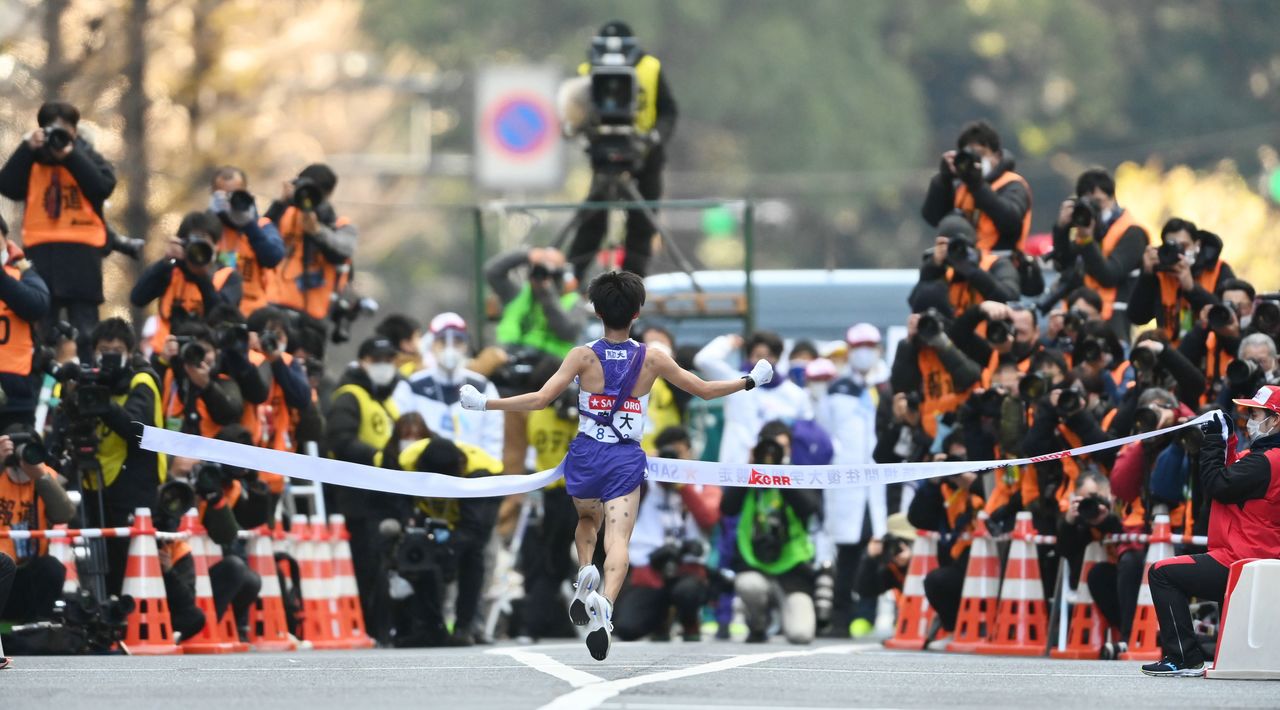
Komazawa University anchor Ishikawa Takuma breaks the tape to win the 2021 Hakone Ekiden. Taken on January 3 in Ōtemachi, Tokyo. (© Jiji)
No matter how big a star a single runner may be, without his teammates he will not enjoy victory in this race. At the same time, though, the competition is challenging enough that even a team that has boosted its performance through determination and long hours of hard work will not win unless its runners make it to the upper echelons of the sport. Running is by its nature a solitary pursuit, but the Japanese nature is to instill athletic endeavor with a focus on teammates helping one another to excel.
One final factor boosting Japanese popular interest in Hakone is the sheer youth of the participants. Just like the Kōshien high school baseball tournaments, these contests come with rich human drama—not just the joy of the victors, but the setbacks and tears of the losers, the comradery of the teammates, and much more to tug on viewers’ heartstrings. Fans of the Hakone Ekiden—as I have been for more than 40 years now—will always be inspired by the stories told by the young runners on the course.
(Originally written in Japanese. Banner photo: The pack early in the first leg of the 2021 Hakone Ekiden on January 2 in Ōta, Tokyo. © Jiji.)